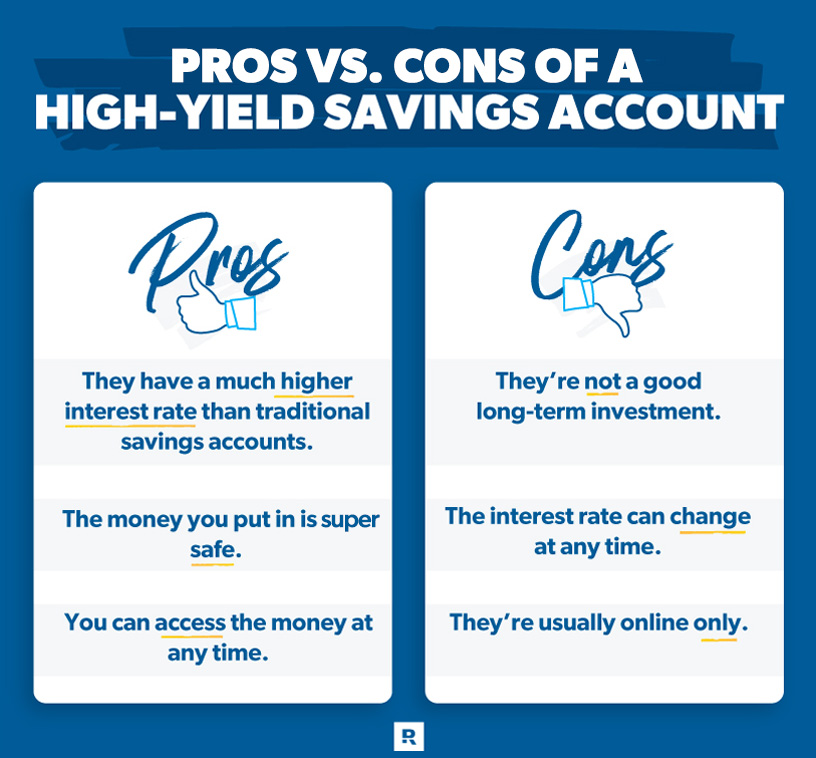What Is a High-Yield Savings Account and Do I Need One?
7 Min Read | Mar 10, 2023

Pop quiz! True or false: The money you put in savings could be earning more interest. The answer? True!
That’s a big deal, since earning more in interest means you can round out your emergency fund a little faster or boost your savings for that dream vacation to Tahiti.
What Is a High-Yield Savings Account?
A high-yield savings account, also called a high-interest savings account, is a type of savings account offered by banks and credit unions with a higher interest rate than traditional savings accounts.
While traditional savings accounts average a 0.35% interest rate, plenty of high-yield savings accounts offer rates of over 3%.1 That’s nearly ten times more!
How a High-Yield Savings Account Works
Here’s how high-yield savings accounts work: By offering a higher interest rate, the accounts can help you turn up the heat on meeting your money goals. Now, we’re not talking bonfire heat. Maybe more like Easy-Bake Oven heat. Still, because high-yield savings accounts offer higher interest rates than traditional savings accounts, the money you put in will grow faster.
So, how are these accounts able to offer such high interest rates? Well, most high-yield savings accounts are available through online banks. And because online banks don’t have to pay rent or any of the other expenses involved in operating a brick-and-mortar building (paying tellers, buying lobby furniture, etc.), the cost of running their businesses isn’t as high. That means they can afford to be more generous with their savings rates.
At this point, you may be wondering, Aren’t higher interest rates a bad thing? They can be, but only if you’re talking about interest rates that come with owing people money. Higher interest rates on things like credit cards, car loans, student loans and mortgages do mean you’ll wind up owing more money on those debts.
But when it comes to a savings account, higher interest rates are a good thing! Because when you’re not dealing with debt, higher interest rates equal more money in your pocket.
Let’s look at an example: Nathan is saving to buy a house, and he puts the $10,000 he’s already saved up into a high-yield savings account at a 3% annual percentage yield (APY). If he doesn’t touch the account for a year, he’ll have earned about $300 in interest by the end of the 12 months.
While $300 might not sound like much, it’s a lot more than Nathan would’ve made by putting the money in a traditional savings account—at the national savings rate of 0.35%, Nathan only would’ve made $35. Not good!
At this point, you may be wondering about the pros and cons of high-yield savings accounts. So here’s a look at what high-yield savings accounts are really good at and what they aren’t.
Benefits of a High-Yield Savings Account
- They have a much higher interest rate than traditional savings accounts. Like, a lot higher. Sometimes, high-yield savings accounts even yield 10 times the savings of traditional accounts.
- The money you put in is super safe. High-yield savings accounts at legitimate banks (online or in person) will be backed by the Federal Deposit Insurance Corporation (FDIC), which insures your deposits up to $250,000 with the backing of the federal government. Your money’s not going anywhere!
- You can access the money at any time. Unlike some investments where it can be difficult to pull your money out at a moment’s notice, high-yield savings accounts allow you to access the money at any time. That makes them a great place for keeping an emergency fund or a down payment fund if you’re saving for a house.
Cons of a High-Yield Savings Account
- They’re not a good long-term investment. Though high-yield savings accounts provide a much higher rate of return than traditional savings accounts, they’re still lousy for long-term investing. Even if a bank offers a rate of 3% or more, it doesn’t come close to the 10–12% rate of return that good mutual funds with long track records of success have historically averaged. That’s where you need to do your long-term investing for retirement or anything else more than five years down the road.
- The interest rate can change at any time. Did you find a great high-yield savings account with an online bank offering a 3.5% interest rate? Well, it may not last long. Banks can change their interest rates for savings accounts whenever they want, which means your rate isn’t a long-term (or even short-term) guarantee.
- They’re usually online only. If you’re the kind of person who hates going to the bank, then this one doesn’t affect you. But if you like being able to talk to your bankers face-to-face and make deposits in person, then getting a high-yield savings account through an online bank may not be your cup of tea.
How to Open a High-Yield Savings Account
Opening a high-yield savings account is a lot like opening a checking account or traditional savings account. First, you’ll need to find a bank or credit union. You can find some great options by searching online for FDIC-insured high-yield savings accounts.
Calculate the growth of your savings account with this free tool.
When considering different banks, check to make sure there are no significant deposit or minimum balance requirements. You don’t want to get hit with any unnecessary fees (banks can be sneaky like that).
And don’t forget to ask if there are any ongoing monthly maintenance fees. You need to avoid those, since they could easily eat up all your interest earnings.
Once you’ve picked out your bank or credit union, you’ll have to provide identification, like a passport or driver’s license, plus your Social Security number. Then you’ll just make a deposit or transfer funds over from another account. Boom—done! Easy, right?
Is a High-Yield Savings Account Right for You?
When deciding whether a high-yield savings account is right for you, it all comes down to what your goal is.
If you’re looking for a place to keep some cash you’ve saved up while getting a nice little bonus, a high-yield savings account definitely fits the bill. It’s a terrific destination for sinking funds or your emergency fund.
But if you’re looking for a place to invest money so it can grow for the future, a high-yield savings account is a bad choice. Like we talked about earlier, investing in good mutual funds is a much better option, as long as you won’t need the money for five years or more.
If you’re interested in long-term investing like that and you want to start making a financial plan for your future, connecting with a SmartVestor Pro is a great place to start.
The Best App for Saving Money
Here’s the thing about savings accounts: You actually have to put money inside them before the interest will do its thing, and that means you’ll need to save money. (They are called savings accounts, after all.)
Saving money is never the easiest thing in the world—and when you aren’t living on a budget, it can be almost impossible. That’s why it’s super important to get on a budget by making a plan for your money before the month begins. And the best place to do that is the free EveryDollar app.
EveryDollar will let you set up a budget in just a few minutes, whether you’re new to this whole budgeting thing or you’ve been doing it for years. Plus, if you upgrade to the premium version, you can connect the app to your bank account so the app can automatically track all your transactions.


